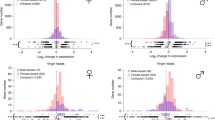Abstract
The sex appeal of aDrosophila melanogaster female is defined here as the stimulus (or set of stimuli) which induces wing vibration in courting males. A quantitative measure of sex appeal is the cumulative duration of wing vibration induced by a given female averaged over several consecutive test intervals using different standardized male testers (sex appeal parameter, SAP). By use of SAP, both males and females are found to have the same amount of sex appeal on the first day after eclosion. However, males rapidly lose it by the next day, so that mature males become distinct from females. We report the ontogeny of the male's response to sex appeal. By the SAP method, we also demonstrate that the male's response is dependent on his previous encounter with females. The sex appeal of 287 gynandromorphs was examined in order to localize the sex appeal focus by means of blastoderm fate mapping. Most mosaic flies were classified as either positive (femalelike, with high SAPs) or negative (malelike, with SAPs of zero). Sixteen percent of the gynandromorphs had intermediate levels of SAP, inducing only short vibrations, a response which males rarely give to normal females. Assuming that the gynanders with such intermediate sex appeal must have both female and male foci, distances to the foci from external landmarks were calculated. The center of the focus seems to be an internal structure mapping to the ventroposterior region of the blastoderm fate map, close to the primordia of the anterior sternites. The focus might include a large mesodermal area, but only part of it must have a female genotype for the sex appeal to be expressed. A possible involvement of the fat bodies in production of the sex appeal stimulus is discussed in relation to these findings. Consistent with this conclusion is the fact that females whose abdomens were amputated still retain enough sex appeal to induce male wing vibrations.
Similar content being viewed by others
References
Averhoff, W. W., and Richardson, R. H. (1974). Pheromonal control of mating patterns inDrosophila melanogaster.Behav. Genet. 4:207–225.
Bastock, M., and Manning, A. (1955). The courtship ofDrosophila melanogaster.Behaviour 8:85–111.
Benzer, S. (1973). Genetic dissection of behavior.Sci. Am. 229:24–37.
Burnet, B., and Connolly, K. (1974). Activity and sexual behavior inDrosophila melanogaster. In Van Abeelen, J. H. F. (ed.),The Genetics of Behavior, North-Holland, Amsterdam.
Butterworth, F. M. (1972). Adipose tissue ofDrosophila melanogaster.Dev. Biol. 28:311–325.
Butterworth, F. M., and Bodenstein, D. (1968). Adipose tissue ofDrosophila melanogaster. III. The effect of the ovary on cell growth and the storage of lipid and glycogen in the adult tissue.J. Exp. Zool. 167:207–218.
Garcia-Bellido, A., and Merriam, J. (1969). Cell lineage of the imaginal discs inDrosophila gynandromorphs.J. Exp. Zool. 170:61–76.
Gill, K. S. (1963). A mutation causing abnormal mating behavior.Drosophila Inform. Serv. 38:33.
Hall, J. C. (1977). Portions of the central nervous system controlling reproductive behavior inDrosophila melanogaster.Behav. Genet. 7:291–312.
Hall, J. C. (1978). Courtship among males due to a male-sterile mutation inDrosophila melanogaster.Behav. Genet. 8:125–141.
Hotta, Y., and Benzer, S. (1972). Mapping of behaviour inDrosophila mosaics.Nature 240:527–535.
Hotta, Y., and Benzer, S. (1976). Courtship inDrosophila mosaics: Sex specific foci for sequential action patterns.Proc. Natl. Acad. Sci. 73:4154–4158.
Janning, W. (1976). Entwicklungsgenetische Untersuchungen an Gynandern vonDrosophila melanogaster.Wilhelm Roux's Arch. 179:349–372.
Lindsley, D. L., and Grell, E. H. (1968).Genetic Variations of Drosophila melanogaster, Carnegie Institution, Washington, D.C.
Manning, A. (1965).Drosophila and the evolution of behaviour.Viewpoints Biol. 4:125–169.
Manning, A. (1967). The control of sexual receptivity in femaleDrosophila.Anim. Behav. 15:239–250.
Nissani, M. (1977). Gynandromorph analysis of some aspects of sexual behaviour ofDrosophila melanogaster.Anim. Behav. 25:555–566.
Postlewaith, J. H., Handler, A., and Gray, P. W. (1976). A genetic approach to the study of juvenile hormone control of vitellogenesis inDrosophila melanogaster. In Gilbert, L. I. (ed.),The Juvenile Hormones, Plenum Press, New York.
Poulson, D. F. (1950). Histogenesis, organogenesis and differentiation in the embryogenesis ofDrosophila melanogaster. In Demerec, M. (ed.),Biology of Drosophila, Hafner, New York.
Shorey, H. H., and Bartell, R. J. (1970). Role of a volatile female sex pheromone in stimulating male courtship inDrosophila melanogaster.Anim. Behav. 18:159–164.
Spieth, H. T. (1952). Mating behaviour within the genusDrosophila (Diptera).Bull. Am. Mus. Nat. Hist. 14:351–366.
Spieth, H. T. (1974). Courtship behavior inDrosophila.Ann. Rev. Entomol. 19:385–405.
Sturtevant, A. H. (1915). Experiments on sex recognition and the problem of sexual selection inDrosophila.J. Anim. Behav. 5:351–366.
Sturtevant, A. H. (1929). The claret mutant type ofDrosophila simulans: A study of chromosome elimination and of cell-lineage.Z. Wiss. Zool. 135:323–356.
Author information
Authors and Affiliations
Additional information
This research was supported by a special project grant for Neurosciences from the Japan Ministry of Education. J. M. J. was a recipient of scholarships from the Japanese Association for the Promotion of Science and from the French Foreign Ministry.
Rights and permissions
About this article
Cite this article
Jallon, JM., Hotta, Y. Genetic and behavioral studies of female sex appeal inDrosophila . Behav Genet 9, 257–275 (1979). https://doi.org/10.1007/BF01068205
Received:
Accepted:
Issue Date:
DOI: https://doi.org/10.1007/BF01068205




